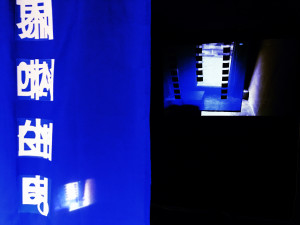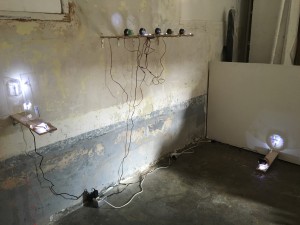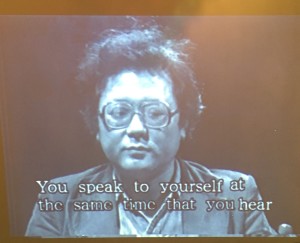인터디스플리너리 아트 페스티벌 도쿄 16/17
Interdisciplinary Art Festival Tokyo 16/17
インターディシプリナリー・アート・フェスティバル・トウキョウ 16/17
Who Kills What Kills Who Kisses?
IAFT16/17 Exhibition in Seoul
Sung Nam HAN 한성남
Shuhei NISHIYAMA 니시야마 슈헤이
Kentaro TAKI 타키 켄타로
Takahiko IIMURA 이이무라 타카히코
2017년 4월 15일〜4월 30일
운영시간: 토–일, 12–5pm, 화–금, 예약제
휴관: 매주 월요일, 국경일
April 15th-30th 2017
Opening hours: Sat–Sun, 12–5pm; Tue–Fri, by appointment
Closed on Mondays and public holidays
서울시 용산구 신흥로 95-9
95-9 Sinheung-ro, Yongsan-gu, Seoul, Korea
http://www.artspaceone.org
2017년 4월 15일 토요일
18:00- 오프닝
19:00- 아티스트 퍼포먼스
2017년 4월 16일 일요일
15:00- 아티스트 토크 (IAFT디렉터/아티스트:한성남)
April 15th 2017 SAT
18:00- Opening
19:00- Artist Performance
April 16th 2017 SUN
15:00- Artist Talk (IAFT director/Artist:Sung Nam HAN)
인터넷과 SNS가 발달하면서, 자신과 타인, 개인과 세계와의 관계는 새로운 국면을 맞이하였다. 본인에게는 일상의 사소한 것일지라도, 동영상 사이트에 올렸다는 이유만으로 쉽게 처벌받을 수 있게 되었다. 별것 아닌 의견이 때때로 논란이 되고, 보수적인 사고방식이 보편화된다. 최대공약수적(最大公約数)인 의견이 탈진실(Post-Truth)화되고, 중요한 정치적 결정이 된다. 한편, 최고 권력자인 대통령이 미디어를 신용하지 않고 SNS상에서 발언함으로써 민중을 직접 통제한다. 역 파놉티콘(Reverse Panopticon)이 붕괴하고, 권력과 민중이 서로 더블 파놉티콘(double panopticon) 상태로 되어 버렸다. 현대 미술이 사회에 경고하는 기능을 아직 가지고 있다면, 이와 같은 혼돈 상황을 어떻게 표현할 수 있을까? 이번 <Who Kills What Kills Who Kisses?> 전에서는 일본을 거점으로 활동 중인 4명의 작가가 참여하여 이를 드러낸다. 한성남(Sung Nam HAN)은 영상과 언어로 개인과 사회를 드러내는데, 작업 속의 ‘푸른 천’은 자신의 정체성을 나타내기도 한다. 니시야마 슈헤이(Shuhei NISHIYAMA)는 조선 시대 백자의 「백(白)」을 테마로 하며, 빛을 보는 것, 빛을 통해 본다는 것을 영상의 구조를 이용해 고찰한다. 타키 켄타로(Kentaro TAKI)는 최소한의 영상장비로 감시사회(監視社会)를 비판하며, 이이무라 타카히코(Takahiko IIMURA)는 비디오의 정체성을 언어과 이미지 사이의 긴장 관계 속에서 묻는다.
Space One invites you to <Who Kills What Kills Who Kisses?> presenting works by four artists based in Tokyo, Japan. Sung Nam HAN, Shuhei NISHIYAMA, Kentaro TAKI, and Takahiko IIMURA show works in various media reflecting the current state of chaos in its everyday technology. As Internet and SNS become a significant part of our everyday life, relations between self and others, individuals and the world becomes a new dimension. A mundane happening uploaded on web becomes a punishable crime. Futile opinions magnify into conflicts and conservative ideologies become popularized. Opinions of the greatest common divisor become post-truth and even a vital political decision maker. At the same time, presidents, the most powerful positions in the world, cease to trust media and manipulate the public through SNS. Reverse Panopticon collapses; both power and civilians are in state of double Panopticons. If contemporary art encompasses the function to warn the society of its future, how do we convey such state of chaos?
HAN reflects on issues of identity, individuality and society using blue cloth in her video and language work. Nishiyama shows video work portraying the seeing of light and seeing through light inspired by Baekja’s (White Porcelain) ‘Baek’ (백(白)) from the Joseon dynasty. Taki examines surveillance society with minimal use of video equipment in a critical point of view and Iimura questions the identity of video medium in its relationship between language and image.
インターネット、SNSの普及により、自己と他者との、個人と世界との関係性は、新たな局面を迎えたと言えるだろう。本人にとって日常の小事でも、動画サイトにアップすることで、簡単に逮捕されるようになった。なにげない意見が、時に炎上し、保守的な考え方が普遍化される。最大公約数的意見が、post-truth化し、重大な政治的決定がなされる。一方、最高権力者である大統領がメディアを信用せず、SNSで発言することにより、ダイレクトに民衆をコントロールする。逆パノプティコンが崩壊し、権力と民衆が、相互にダブル・パノプティコン状態と化してしまった。コンテンポラリー・アートが、社会へ警告を行う機能を未だ保っているのであれば、このような混沌とした状況をどのように表現できるだろうか。今回のWho Kills What Kills Who Kisses?展では、日本を拠点とした4名のアーティストが参加する。韓成南は自身のアイデンティティーをブルーバックを使って、個と社会を映像と言語により表現する。西山修平は、李朝期の白磁の「白」をテーマに、光を見ること、光により見ることを、映像の構造を用いて考察する。瀧健太郎は、最小限の装置で、監視社会を批判する。飯村隆彦は、ビデオにおけるアイデンティティーを、言葉とイメージの間の緊張した関係のなかで、問いかける。
주최
인터디스플리너리 아트 페스티벌 도쿄
Presented by Interdisciplinary Art Festival Tokyo
主催:インターディシプリナリー・アート・フェスティバル・トウキョウ
후원
아트 카운슬 도쿄 (도쿄도 역사문화재단)
Supported by Arts Council Tokyo (Tokyo Metropolitan Foundation for History and Culture)
助成:アーツカウンシル東京(公益財団法人東京都歴史文化財団)
후원
인디내셔널
Patron by INDInational
참여 작가
한성남 韓成南 Sung Nam HAN
1980년, 일본 고베 출생
오디오 비주얼 아티스트이자 IAFT의 디렉터인 한성남 작가는 언어, 색, 사운드, 이미지 등을 기호학적으로 접근하고, 종종 갑작스러운 시각적 효과들을 이용하여 작업한다. 그는 비디오 작업에서부터 설치와 아트 퍼포먼스로 작업의 범위를 확장하여, 인간 / 성(sex) / 종교에 관한 사회적 규범들을 탐색한다. 서울국제실험영화페스티벌(EXiS), 서울국제뉴미디어페스티벌(NEMAF), Lausanne Underground Film and Music Festival(LUFF), International Short Film Festival Detmold (ISFF) 등 국내외 영화, 미디어 페스티벌에 참여하였으며, 그 외 Tokyo Wonder Site(TWS)에서 열린 Asia Anarchy Alliance에서의 오프닝 퍼포먼스 진행, 모리 유 갤러리(MORI YU GALLERY)나 Asia Culture Center Creation에서 작품을 선보였다.
http://jonart.net
Audio Visual Artist and Director of the Interdisciplinary Art Festival Tokyo, Sung Nam Han makes work with a semiological approach to language, color, sound and image and often employing abrupt visual effects. Han’s practice expands from video works, to installations and art performances, exploring the social code of human/sex/religion. A lot of works has been shown in domestic & international such as Experimental Film and Video Festival in Seoul, Seoul New Media Festival [Media Artist prize], Lausanne Underground Film and Music Festival, International Short Film Festival Detmold, Opening performance in Asia Anarchy Alliance at Tokyo wonder site, exhibition in MORI YU GALLERY, Asia Culture Center Creation in Gwangju, etc.
http://jonart.net
Blue Back Hole Korea
2017, 14min., dimensions variable; blue cloth, monitor, projector, video camera, web camera, speaker, pc, cable
한성남 작가는 재일본 한국동포로서 자신의 정체성을 푸른 천으로 나타내며, 영상과 언어로 개인과 사회를 드러낸다. 영상이 설치된 전시 공간은 현실과 허구가 스위칭 되어 관람객을 혼란스럽게 만든다. 푸른 천에는 일본어, 한국어, 영어가 겹친 조어가 쓰여 있고, 작가는 퍼포먼스를 통해 시 같은 문장을 반복하여 말한다. 이번 전시에서는 이러한 퍼포먼스 영상 외 황궁이나 파리에서 촬영한 작가의 작품 및 다큐멘터리를 살펴볼 수 있다.
作家は自身の在日コリアンというアイデンティティーを思考し、
HAN reflects on her identity as Korean living in Japan and expresses issues of individuality and society by video using blue cloth and words. Video which is switched between reality and fiction makes audience confused in the installation space. Coined words overlapping Japanese/Korean/English are written on a swigging blue cloth and images of HAN who reads the words like a poem over and over again in the performance are shown. Other moving images are shown such like documentary, the Imperial Palace in Tokyo, Paris scenery on the screen and the monitor.
니시야마 슈헤이 西山修平 Shuhei NISHIYAMA
1976년, 일본 가마쿠라 출생
슈헤이 니시야마는 비디오를 미디어 매체로 사유하여 이미지가 넘쳐 흐르는 현대사회를 비판한다. 그의 작업은 현실 세계를 이미지와 사운드로 분리하고 이를 비디오의 논리로 재구성하여 비디오가 실현한 세계를 보여준다. 현재 작가는 싱글채널 비디오와 설치, 퍼포먼스 작업 등을 하고 있다. 2007년부터 2008년까지 호주에서 머물며 개인전을 열었으며, 2009년 이후 도쿄에 거주하며 작업하고 있다. 2015년 대만의 가장 큰 음악축제인 <T-Fest>에서 퍼포먼스를 진행하였고, 최근 모리 유 갤러리(MORI YU GALLERY) 에서 비디오 설치 작업을 선보였다. 프랑스, 독일, 미국, 브라질, 인도네시아, 말레이시아, 한국 등 국내외 유수의 영화, 미디어 페스티벌에서 싱글 채널 작업을 상영하였다.
www.shuhei2480.net
Born in 1976, Kanagawa Prefecture, Japan.
Shuhei Nishiyama makes works to criticize the modern society in which images are flooded by thinking of video as media. The works represent the world where the video realized by separating the real world to image and sound and reorganizing them in the logic of video. Making single channel video, installation, performance works. Stayed and had an individual exhibition in in Australia from 2007 to 2008. Living and making works in Tokyo from 2009. He showed installation works for “Videos” MORI YU GALLERY in 2016, 2017 and did a performance for “T-fest” which is the biggest music festival in Taiwan in 2015. His single channel works has been shown for many film and media art festivals in France, Germany, America, Brazil, Indonesia, Malaysia, and Korea.
www.shuhei2480.net
white light is white
2017, dimensions variable; LED, video camera, earphone, projector, Microphone, cable
조선 시대 백자는 유기적인 백색을 띠고 있다. 이는 ‘무’(無)로서의 백색보다는 ‘유’(有)로서의 백색이다. 또한 있는 것을 보기 위한 배경이 아닌, 보는 것 자체로서 존재하는 백색이다. 백자의 흰색은 빛을 본다는 것, 빛을 통해 보이는 것이 무엇인지를 묻는다. 영상은 빛 자체를 보는 것이다. 영상에서 흰색은 빛의 삼원색인 빨강, 초록, 파랑의 픽셀이 균등하게 섞여서 생긴다. –작가 노트
슈헤이 니시야마는 영상의 원리적인 방법을 이용하여 이러한 ‘흰색’을 만든다. 작가는 영상의 최소 단위인 하나의 픽셀을 빨강, 초록, 파란 LED 조명을 합쳐 생성하는데, 이 삼원소가 섞이면서 흰색이 된다. ‘비디오 피드백’에 색상을 중첩하면 가장 강력한 RGB 출력이 있는 상태의 순수한 흰색이 화면 중앙에 생성된다. 이 흰색 영상은 전자 신호로 즉시 복제되며, 같은 전자 신호인 음성 신호로도 변환된다.
李朝期の白磁は有機的な白である。それは、無としての白というより、有としての白である。またそれは、あるものを見るための背景としての白ではなく、見るものとしての白である。
白磁の白は、光を見ることとは、光により見ることは何かを問いかける。
そして、映像とは光そのものを見ることである。映像における白は光の三原色、赤、緑、青のピクセルが均等に混ざり合うことにより生まれる。
この作品では、映像における白を、映像の原理的方法により、生み出す。
スクリーンでは、ビデオフィードバックが色を重ね合うことにより、画面の中心に映像における純粋な白、最も強くRGBが出力された状態を生み出す。
また、映像の最小単位である1ピクセルを、3つのLED ライトにより、作り出す。そこでは赤、緑、青の光が重ね合うことにより、白を作り出す。
さらに、ここで生み出された白い映像は、電子信号として、すぐに複製されている。そして、この映像は同じ電子信号である音声信号にも変換される。
White pod in Joseon Dynasty is organic white. It is not white as nothing but white as being. And it is not white as background to see something but white to see itself.
White of the white pod is questioning what seeing light or seeing by light is.
And video is seeing light itself. White of video is made by blending red, green, blue pixels of the three primary colors of light.
In this work, white of video is made by the primary way of video.
Video feed back makes pure white in the center of screen which is the strongest output of RGB lights on the screen.
And 1 pixel as the minimum unit of video is made by three LED lights. White is made by overlapping red, green and blue light.
Then the video of white light is duplicated as electric signal immediately. And this video is translated into audio signals from video signals as the same electric signals.
타키 켄타로 瀧健太郎 Kentaro TAKI
1973년, 일본 오사카 출생
대표 경력으로 아시안 아트 비엔날레 2009 (대만 국립현대미술관), Video Life (2011, ST Paul St Gallery, 뉴질랜드), 코가네초 바자르(Koganecho Bazaar)(2011, 요코하마), Les Instant Video:50 ANS D’ARTS VIDEO (2013, 마르세유), VIDEOFORMES 2016 (클레르 몽페랑, 프랑스), Regeneration Movement: Rethinking Technology in the Digital Age (2016, 대만 국립현대미술)에 참여하였고, 최근 베를린에서 개인전 <Rende-vous in Syndro-Polis> (2016, TWS-Berlin, 독일)을 개최하였다. 또한 일본 비디오아트의 선구자들에 대한 다큐멘터리 비디오 <Kikai de Mirukoto=Eye Machine/To see by Chance>(2011)를 감독하였다. 2002년과 2003년도에는 각각 Cultural Agency of Japan 지원 해외 파견 작가로, POLA Art Foundation 지원으로 독일의 칼스루에서 작업한 바 있다.
http://takiscope.jp
Born Osaka,Japan in ’73.As dispatched artist granted by Cultural Agency of Japan(‘02), POLA Art Foundation (‘03) in Karlsruhe. Germany. Participated “Asian Art Biennial2009″(Taiwan National Art Museum), “Video Life”(2011, ST Paul St Gallery, NZ), Koganecho Bazaar(2011, Yokohama), “Les Instant Video:50 ANS D’ARTS VIDEO”(2013, Marseille),VIDEOFORMES2016(Clermont-Ferrand, France), “Regeneration Movement: Rethinking Technology in the Digital Age” (2016, Taiwan National Museum of Fine Arts, Taichung, Taiwan), “Rende-vous in Syndro-Polis”(solo-show, 2016, TWS-Berlin, Germany) etc. directed a documentary video about pioneers of Japanese Videoartists “”Kikai de Mirukoto=Eye Machine/To See by Chance”(2011).
http://takiscope.jp
Allegory of the Electric Cave
2017, LED, motor, Plastic figure, PVC sheet
켄타로 타키는 오늘날 영화, 예술, 건축 등이 점점 상품화되면서, 모든 것이 키치에 빠져버렸다고 언급한다. 그의 이번 작업은 LED 광원으로 투사한 그림자를 통해 감시 사회, 매스 미디어, 전쟁 기계 등의 테마를 벽면에 축도하여 보여주는데, 이는 사회의 중요한 이슈나 진실을 보기 위한 습작으로서 플라톤의 ‘동굴의 비유’에서 영감을 받았다.
映画もアートも建築も、何もかもがコモディティ化し、今日すべてはキッチュに陥ってしまったようだ。重要なものや真実を見る為に、プラトンの「洞窟の比喩」にヒントを得て習作とした。監視社会、マスメディア、戦争機械をテーマに、LED光源によって照射された影が壁面でその縮図を見せる。
Film, art and architecture…, everything has been commoditized and all things now seem to be kitch !
The author tries to seek for important things and to see the truth, so that he quotes “Allegory of the Cave” by Plato, and made study piece from its idea. 3 different themes as “surveillance society”, “mass media” and “war machines” are irradiated by LED lights on the wall to show us miniature of those as shadows.
이이무라 타카히코 飯村隆彦 Takahiko IIMURA
1937년, 일본 도쿄 출생
타카히코 이이무라는 일본의 실험영화와 비디오아트 분야의 선구적인 작가이자 세계적으로 유명한 작가로서, 1960년부터 영화 작업을 시작하여 1970년 이후 뉴욕과 도쿄에 거주하며 작업 하고 있다. 베를린 예술원, 이탈리아의 록펠러 파운데이션 벨라지오 센터의 레지던시에 참여, 뉴욕현대미술관, 휘트니 뮤지엄, 앤솔로지 필름 아카이브, 파리의 퐁피두 센터, 주드폼 미술관, 릴 뮤지엄, 레이나 소피아 국립미술센터, 도쿄도 사진 미술관 등 해외 유수의 미술관에서 개인전을 개최하였다.
http://www.takaiimura.com
Takahiko Iimura has been a pioneer artist of Japanese experimental film and video, working with film since l960 and with video since 1970 while residing in New York and Tokyo. He is a widely established international artist, having numerous solo exhibitions in major museums such as the Museum of Modern Art, New York, the Whitney Museum, New York, Anthology Film Archives, New York, Centre George Pompidou, Paris, the National Gallery Jeu de Paume, Paris, Palais des Beaux-Arts, Brussels, Reina Sofia National Museum, Madrid, and the Tokyo Metropolitan Museum of Photography, Tokyo in addition to an artist residency at the German Academy of Arts, Berlin, and Bellagio Rockefeller Foundation Study Center, Bellagio, Italy.
Talking to Myself
1978, revised in 2001, 7min. single channel video
타카히코 이이무라의 1978년 작 <Talking to Myself>(revised in 2001)는 프랑스 철학자인 자크 데리다의 주요 저서 ‘목소리와 현상’ (David B. Alison / 영어 번역)에서 인용한 문장에서 기초하였다. 작가가 인용한 문장인 ‘I hear myself at the same time that I speak (나는 내가 말하는 것을 동시에 듣는다)’는 데리다의 ‘현상학적 본질’을 잘 나타내고 있으며, 당시 앨리슨 교수는 이 비디오 아트 작업에 관해 “데리다의 철학 사조를 이용한 가장 강력하고, 가장 효과적인 스테이트먼트”라고 언급하며 높이 평가한 바 있다.
フランスの哲学者、ジャック・デリダの主要な著書「声と現象」(デヴィット・B・アリスンの英訳)から引用した1文に基ずいて、 “Talking to Myself” を 1978 年(revised in 2001)に制作した。そのビデオは、アリスン教授によって、「デリダの作品から創作し得た最も強力で,最も効果的なステートメント」として、高く評価された。私が引用した文は,デリダが「現象学的な本質」と呼ぶもので,英文ではI hear myself at the same time that I speak(私は、私が話すことを,同時に聞く)である。
Based on a sentence taken from a seminal book by the French philosopher, Jacques Derrida, “Speech and Phenomena” (translated by David B. Allison), I produced the “Talking to Myself” in 1978 (revised in 2001). The video was highly appreciated as “the strongest, most effective statement one could make from the work of Derrida” by Professor Allison. The sentence I quoted, that Derrida calls “phenomenological essence,” appears in the translation as I hear myself at the same time that I speak.
<Interdisciplinary Art Festival Tokyo>
IAFT(Interdisciplinary Art Festival Tokyo)는 장소와 관객이 특정 장르에 고정되는 상황을 허물고, 인터디스플리너리 아트의 관점에서 새로운 가치와 관객을 만들고자 설립되었다. “인터디스플리너리 아트”는 장르나 분야를 넘나들며 범주화되지 않는 예술을 의미한다. 주로 연극, 비디오, 음악, 인형극 분야에서 활동하는 작가들이 페스티벌에 참여하여, 그들의 무장르, 무경계적 작업과 퍼포먼스를 도쿄와 대만의 여러 장소에서 선보이고 있다. 프로젝트에 대한 자세한 정보는 웹사이트에서 확인할 수 있다.
http://i-a-f-t.net





